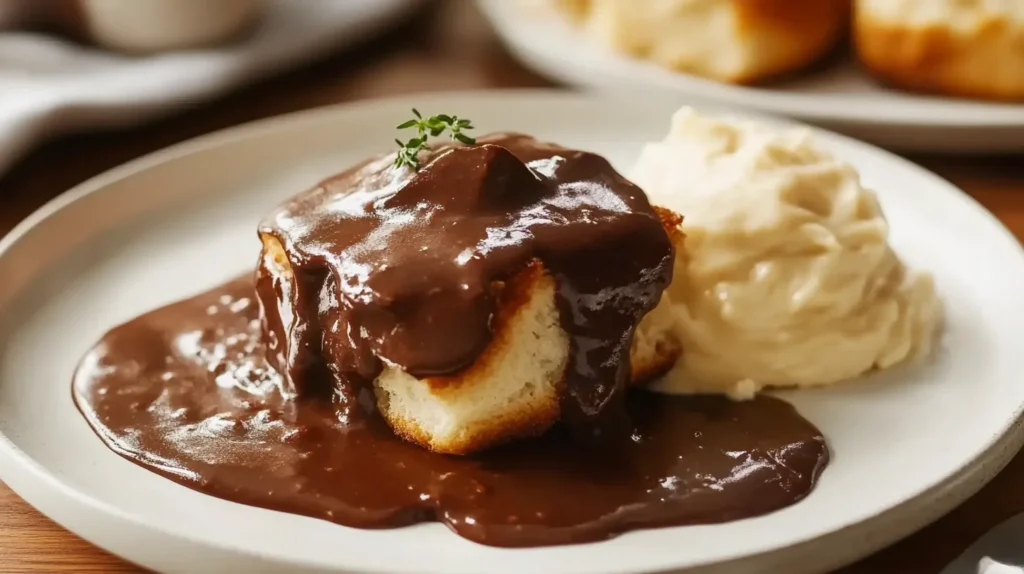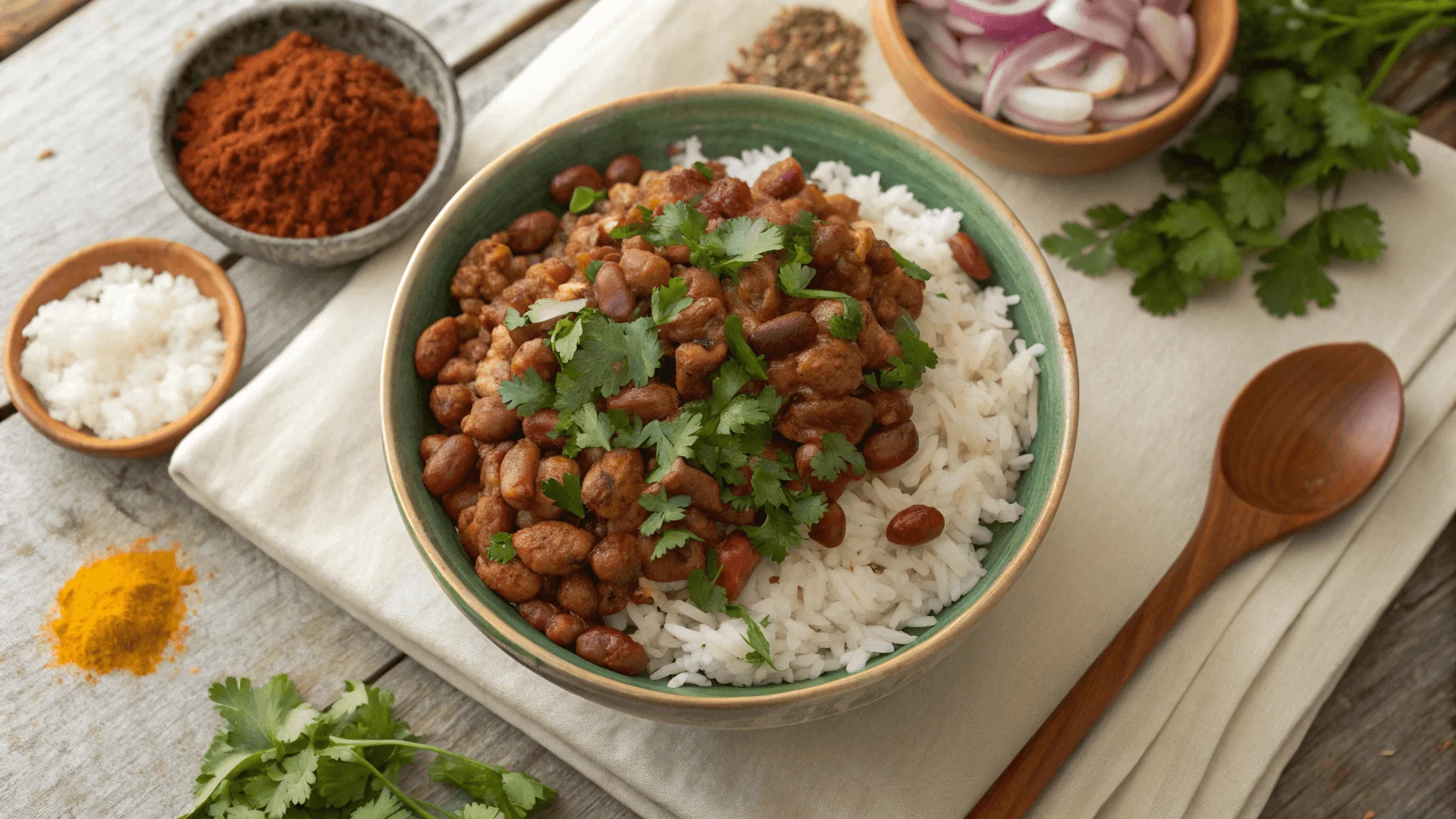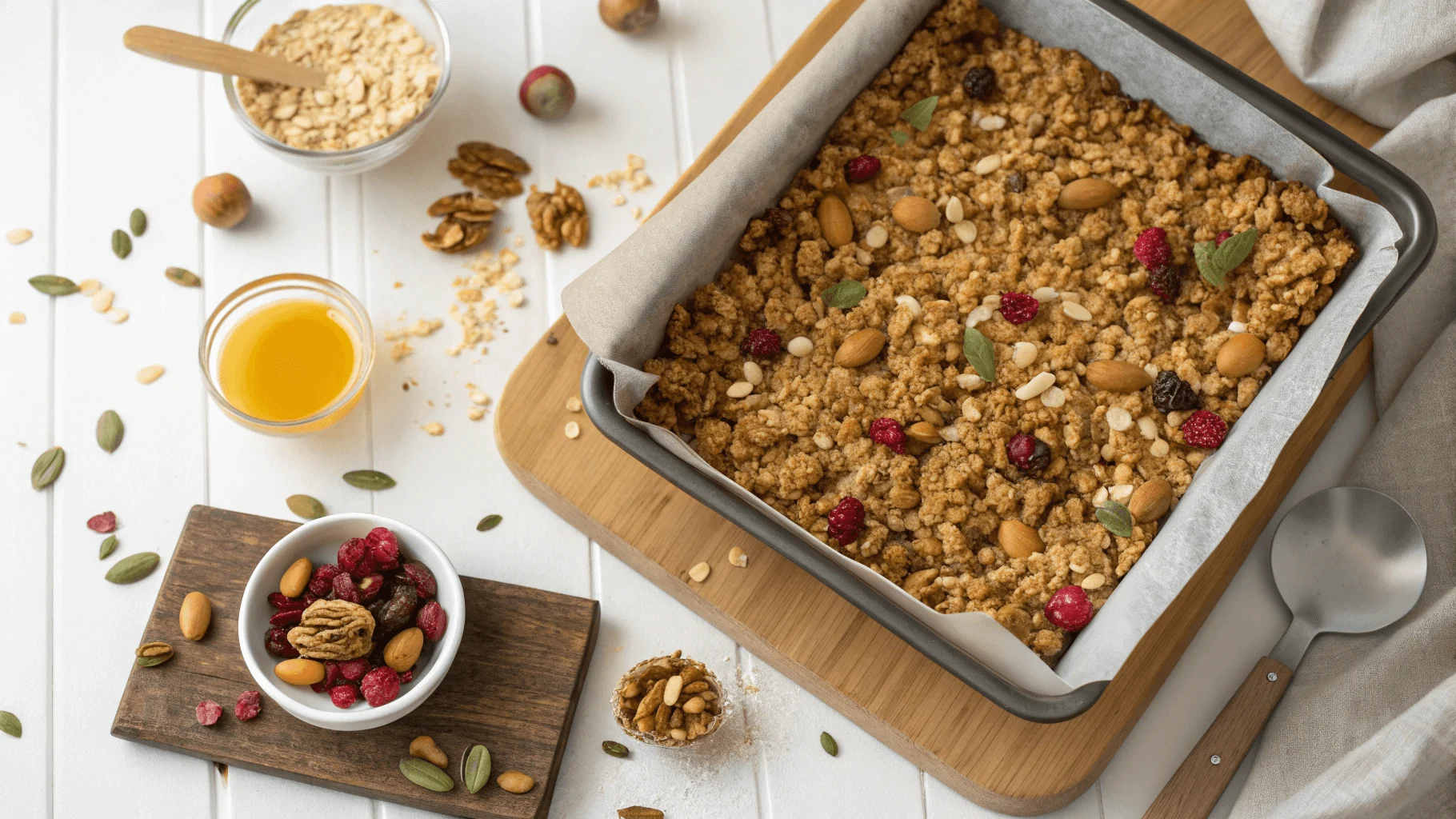Gravy is more than just a sauce—it’s a defining element that can elevate any meal, turning ordinary dishes into extraordinary culinary experiences. Whether poured over mashed potatoes, turkey, or roasted vegetables, perfect gravy has a way of bringing comfort and flavor to every bite. But crafting gravy that achieves the ideal balance of flavor, texture, and consistency isn’t as simple as it seems.
In this guide, we’ll explore what the secret to good gravy is and break down not only the essential techniques but also the ingredients and tools needed to master this timeless accompaniment.
By understanding these elements step by step, you’ll gain the confidence to create gravy that enhances any meal.
Whether you’re a seasoned cook or a beginner in the kitchen, this guide will equip you with the knowledge and skills to elevate your culinary creations.
What is the Secret to Good Gravy? Understanding the Basics
Gravy is a savory sauce that is made by combining pan drippings, broth, or stock with thickening agents such as flour or cornstarch.
Not only does it serve as a rich addition to a meal, but it also plays a crucial role in complementing and enhancing the flavors of the dishes it’s served with.
Furthermore, its smooth texture and deep flavor profile make it a versatile accompaniment for a variety of meals, from roasted meats to mashed potatoes. Consequently, gravy has become a staple in many cuisines, adding a touch of indulgence and harmony to every bite.
Why Gravy Matters
- It adds moisture and richness to dishes.
- It harmonizes flavors, acting as a bridge between various components of a meal.
- It contributes to a meal’s visual appeal, creating a luscious finish.
Understanding the fundamentals of gravy is crucial to unlocking its potential as an essential culinary element. Discover the perfect guide to chocolate gravy.
What Makes Gravy Exceptional? The Core Components Explained
To create good gravy, you need the right combination of core components:
Pan Drippings:
- These provide depth and richness: The browned bits at the bottom of a roasting pan (fond) are packed with umami flavor.
Liquid Base Options include:
- Stock or Broth: Chicken, beef, or vegetable stock forms the backbone of gravy.
- Milk or Cream: Used in white gravy for added creaminess.
Thickening Agents:
- Flour: Creates a roux for a traditional gravy.
- Cornstarch: Ideal for a glossy, translucent finish.
Mastering these ingredients is key to understanding the art of creating unique gravies like chocolate gravy.
What is the Secret to Good Gravy? Techniques for Foolproof Results
Making gravy is as much about technique as it is about ingredients. Follow these steps for guaranteed success:
Deglazing the Pan: After roasting, deglaze the pan with liquid to lift the flavorful bits stuck to the bottom.
Creating a Roux: Combine fat (butter or drippings) with flour and cook until golden brown for a nutty flavor.
Incorporating the Liquid: Gradually whisk in warm stock or broth to avoid lumps, ensuring a smooth texture.
Simmering and Seasoning: Let the mixture simmer to develop flavor, then season with salt, pepper, and optional herbs.
By refining these techniques, you’ll not only discover the secret to good gravy but also understand how mastering these foundational steps transforms your cooking.
Moreover, as you practice, you’ll notice how the balance of flavors and textures comes together seamlessly.
Additionally, these methods provide a reliable framework that ensures consistency and quality every time you prepare gravy.
Each step builds toward a perfect sauce, revealing secrets to exceptional gravy-making.
Unlocking Flavor: What is the Secret to Good Gravy Beyond the Basics?
To elevate your gravy beyond the basics, consider these flavor-enhancing additions:
- Herbs and Spices: Add thyme, rosemary, or sage for depth.
- Aromatics: Sautéed onions or garlic can add complexity.
- Acidity: A splash of wine or vinegar balances richness.
- Umami Boosters: Soy sauce, Worcestershire sauce, or mushroom powder amplify savory notes.
By thoughtfully incorporating these elements, you can transform your gravy from good to exceptional. As you master these techniques, you’ll uncover the secret to creating truly remarkable gravy.
Moreover, each ingredient and step plays a vital role, seamlessly coming together to elevate your dish. Ultimately, the perfect gravy is within reach when you pay close attention to every detail and allow these elements to work in harmony.
Common Gravy Mistakes: What to Avoid and How to Fix Them
Even experienced cooks can stumble when making gravy. Here’s how to avoid common pitfalls:
- Lumpy Texture: Whisk continuously while adding liquid to prevent clumping.
- Greasy Consistency: Skim excess fat from the drippings before making your gravy.
- Lack of Flavor: Use well-seasoned drippings and high-quality stock.
- Too Thin or Too Thick: Adjust the liquid or thickening agent to reach the desired consistency.
By avoiding these errors, you ensure your gravy turns out flawless every time. Furthermore, this reinforces the understanding of what truly makes good gravy.
In addition, paying close attention to these details enhances the flavor and consistency of your dish, guaranteeing it’s a standout at every meal. Ultimately, mastering these techniques not only prevents common mistakes but also elevates your cooking skills to a new level.
Exploring the World’s Gravy: What is the Secret to Good Gravy in Other Cultures?
Gravy is a universal delight, and its appeal lies in its versatility and adaptability. In fact, regional variations highlight its diverse nature, offering unique flavors and textures that cater to different palates.
For example, in Southern American cuisine, rich, creamy sausage gravy is a breakfast staple, while in the United Kingdom, smooth onion gravy is a classic accompaniment to Sunday roasts.
Furthermore, in Indian cuisine, gravies often feature a blend of aromatic spices and herbs, creating vibrant dishes like butter chicken and masala curries. Clearly, no matter where you go, gravy plays a vital role in elevating meals with its comforting, flavorful essence:
- American Southern Gravy: Cream-based, often served with biscuits.
- French Sauce Espagnole: A brown sauce with a rich, complex flavor.
- Japanese Curry Gravy: Thickened with roux and infused with curry spices.
- British Onion Gravy: Loaded with caramelized onions for sweetness.
Each variation highlights unique ingredients and techniques, offering diverse ways to explore what is the secret to good gravy.
Pairing Gravy with Meals: What is the Secret to Good Gravy Pairings?
Gravy truly shines when paired with the right dishes. To illustrate, here are some classic combinations that highlight its delicious versatility:
- Roasted Meats: Turkey, chicken, or beef.
- Mashed Potatoes: A quintessential duo.
- Vegetables: Roasted or steamed for added flavor.
- Biscuits: A Southern staple.
By matching your gravy to the dish, you enhance the dining experience and uncover what is the secret to good gravy for each pairing.
The Science of Gravy: Understanding Ingredient Interactions
Gravy-making is both a science and an art, requiring a delicate balance of chemistry and creativity.
To achieve the perfect consistency and flavor, it is essential to understand a few key scientific principles.
For instance, the interaction between fat and flour, which forms the base of many gravies, plays a crucial role in thickening.
Additionally, the gradual incorporation of liquid ensures a smooth texture while preventing lumps. Furthermore, the timing and temperature of cooking significantly impact the final outcome.
With careful attention to these details, the process transforms simple ingredients into a rich, velvety sauce that enhances any dish:
- Emulsification: Combining fat and liquid into a smooth mixture.
- Gelatinization: Thickening agents like flour interact with heat to form a stable structure.
- Maillard Reaction: Pan drippings develop flavor through browning.
Understanding these interactions reveals what is the secret to good gravy, enabling you to fine-tune your recipes.
Tools of the Trade: Essential Equipment for Gravy Success
Having the right tools is essential for ensuring a smooth gravy-making process:
To start, a whisk is indispensable, as it helps blend the ingredients seamlessly, leaving no room for lumps.
Next, a saucepan is crucial, as it provides even heating, which is vital for achieving the perfect consistency.
Additionally, a fat separator plays a key role in removing excess grease, allowing you to create a rich and balanced flavor. Finally, a strainer ensures a silky finish by eliminating any unwanted particles.
By equipping your kitchen with these essentials, you can confidently prepare to uncover the secret to making great gravy every time you cook.
Quick Fixes for Gravy Emergencies: Discover What Is the Secret to Good Gravy
Gravy emergencies can arise unexpectedly, especially when you’re hosting a dinner or preparing a festive meal. Understanding quick fixes can save the day:
- Too Thin: Mix a slurry of cornstarch or flour with cold water, then whisk it into the gravy. Simmer for a few minutes.
- Too Thick: Gradually add warm broth, stirring constantly, to achieve the desired consistency.
- Lumpy Gravy: Use a fine mesh strainer to remove lumps or blend the gravy until smooth.
- Too Salty: Add a potato slice to the gravy and simmer briefly to absorb excess salt.
- Lacking Flavor: Enhance with a splash of soy sauce, Worcestershire sauce, or a dash of fresh herbs.
Transitioning smoothly through these techniques can keep your gravy delicious and presentable, even under pressure.
Seasonal Gravy Recipes for Festive Occasions: The Secret to Good Gravy
Seasonal festivities call for gravies that complement the flavors of the moment. Here’s a breakdown of seasonal inspirations:
- Thanksgiving: Classic turkey gravy made with pan drippings and seasoned with sage and thyme.
- Christmas: Rich red wine gravy, perfect for roast beef or lamb, infused with rosemary and garlic.
- Spring Celebrations: Light lemon herb gravy, ideal for pairing with roast chicken or fish.
- Summer Gatherings: Mushroom gravy with a hint of white wine, excellent for grilled meats.
Each season offers an opportunity to explore unique flavors while asking, What is the Secret to Good Gravy? It lies in using fresh, high-quality ingredients that reflect the season’s essence.
How to Make Gravy Healthier Without Losing Flavor: What Is the Secret to Good Gravy?
Traditional gravies can be calorie-dense, but small adjustments can make them healthier without sacrificing flavor:
- Use a low-sodium broth or stock to reduce salt content.
- Opt for whole-grain flours or arrowroot powder as thickeners.
- Replace heavy cream with Greek yogurt or unsweetened almond milk.
- Add flavor through herbs and spices like thyme, garlic, or smoked paprika instead of relying on butter or fats.
The secret to good gravy lies in balancing flavor while minimizing unnecessary fats. These alternatives ensure that the gravy remains tasty, light, and guilt-free.
Classic Gravy Recipes for Every Occasion
Classic gravy recipes never go out of style and remain staples in kitchens worldwide. Some enduring favorites include:
- Brown Gravy: Made with pan drippings, beef stock, and flour for hearty flavor.
- Country Gravy: A creamy version with sausage or bacon bits, often paired with biscuits.
- Giblet Gravy: Traditional during Thanksgiving, made with turkey giblets and hard-boiled eggs.
- Onion Gravy: Rich and savory, perfect for sausages or mashed potatoes.
When crafting these recipes, What is the Secret to Good Gravy? The answer lies in layering flavors and ensuring the consistency matches the dish.
The Role of Gravy in Modern and Traditional Cuisine
Gravy serves as a bridge between the old and the new, deeply rooted in culinary history while evolving with trends:
- In traditional cuisine, it highlights rustic flavors and makes use of pan drippings, ensuring nothing goes to waste.
- In modern cooking, gravy often takes on fusion twists, such as miso gravy or spicy chipotle variations.
- Gravy also serves a functional purpose, tying together the flavors of a dish.
Its enduring popularity shows that What is the Secret to Good Gravy? lies in its ability to adapt to different tastes while preserving its comforting essence.
Secrets from Professional Chefs for Perfect Gravy
Professional chefs have mastered the art of gravy-making, and their insights can elevate your technique:
- Deglaze the Pan: Use wine or broth to scrape up caramelized bits for deeper flavor.
- Use Homemade Stock: Store-bought options can’t compare to the rich taste of fresh stock.
- Season Gradually: Add salt and seasonings in stages to avoid overpowering the gravy.
- Strain the Gravy: A smooth texture makes all the difference.
By focusing on these details, you’ll unlock What is the Secret to Good Gravy? It’s all about precision and patience in every step.
The Economics of Gravy: Making Delicious Gravy on a Budget
Gravy can be an economical addition to meals, stretching ingredients while enhancing flavors:
- Use pan drippings and kitchen scraps like onion peels or herb stems to create a rich stock.
- Thicken with flour or cornstarch, which are both inexpensive pantry staples.
- Boost flavor with soy sauce or a splash of vinegar instead of costly specialty ingredients.
Gravy proves that culinary excellence doesn’t have to be expensive. The secret to good gravy often lies in creativity with simple, affordable ingredients.
Exploring Gravy’s Role in Comfort Food Culture
Gravy is more than just a sauce—it’s the heart of comfort food culture. Whether poured over mashed potatoes or biscuits, it evokes a sense of warmth and nostalgia.
- It’s a staple in southern cuisine, where rich gravies accompany fried chicken or pork chops.
- In British food culture, onion gravy is essential for Sunday roasts and pies.
- Globally, variations like Japanese curry gravy or poutine’s brown gravy offer a cultural twist.
Comfort food isn’t complete without gravy, proving once again that What is the Secret to Good Gravy? lies in its ability to bring people together.
FAQs: Mastering the Secret to Good Gravy
Q: What is the key to lump-free gravy?
A: Whisk constantly while adding the thickener, and strain if necessary.
Q: Can I make gravy ahead of time?
A: Yes, you can prepare gravy in advance to save time.
For example, if you’re planning a big meal, this can help reduce stress on the day of the event. To store it, simply keep it in the fridge for up to three days, ensuring it remains fresh and safe to consume.
Alternatively, for longer storage, you can freeze the gravy, which not only helps retain its flavor and consistency but also makes it convenient to reheat when needed.
Q: How do I fix bland gravy?
A: If your gravy tastes bland, there are several ways to enhance its flavor.
For example, you can add a splash of soy sauce or Worcestershire sauce to introduce savory depth. Additionally, fresh herbs like thyme or parsley can bring a vibrant, aromatic touch, making the gravy more appealing.
Q: What is the secret to good gravy?
A: The secret to creating the perfect gravy lies in achieving a delicate balance of flavor, consistency, and freshness. To start, focus on developing a rich, savory taste by using quality ingredients.
Then, ensure the texture is smooth and velvety, avoiding lumps. Finally, serve it fresh to maintain its full flavor and appeal.
Conclusion
In conclusion, Gravy is a versatile and essential part of many cuisines, from classic recipes to modern adaptations. Whether you’re fixing a gravy emergency, creating a healthier version, or exploring its role in comfort food, understanding What is the Secret to Good Gravy? ensures every meal is enhanced with rich, flavorful sauce. By thoughtfully applying professional tips, carefully embracing seasonal ingredients, and consistently experimenting with techniques, you can successfully master the art of gravy-making and significantly elevate every dish it accompanies.





